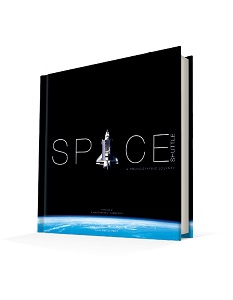The US Space Shuttle fleet may have been retired in 2011, but that doesn’t stop people writing books about it and ‘keeping the dream alive’, as the cliché has it. This one is a “photographic journey” that “curates the finest NASA images into one inspirational collection”. And it’s a very solid, well-produced volume.
The main body of the book is divided into four sections that illustrate key mission phases: Launch Pad, Lift-off, In Space and Landing. The pre-launch phase, covered by the first section, is in some ways the most iconic, simply because – in 135 missions – there were plenty of opportunities for photographers to observe the vehicle, waiting for launch. The in-orbit section is the longest, at over 100 pages, and this is testament to the many hours spent orbiting the Earth with increasingly camera-happy astronauts aboard; in keeping with reality, the launch and landing sections are shorter.
How did the author choose? He searched through “thousands upon thousands of official NASA photographs, changing my mind constantly but ultimately [staying] true to my original concept”, which was to “focus primarily on the shuttle itself [and] pay homage to the…sheer beauty of the design, detail and elegance of the spacecraft”.
From the cover design - which features a top view of the Orbiter for the ‘A’ of Space - the iconic nature of the Space Shuttle is evident: from its symmetrical stance on the pad to its delta-wing silhouette gliding to a landing; from the raw power of the solid rocket booster flames to the stark clarity of the silent Orbiter engines in space. It’s always difficult to choose favourites, but the STS-130 image taken from the International Space Station must be among them: it shows a tiny Orbiter, nose towards Earth, silhouetted against three distinct layers of the atmosphere - an orange-clouded troposphere, a white stratosphere and a blue mesosphere, which darkens to the blackness of space above.
Being a photographic book it is text-light, but there is a foreword from former astronaut Chris Ferguson, a two-page introduction from the author and 15 pages of mission data. An additional nine pages of mission insignias is particularly nice, as both a visual record and a study of graphic art for a very specific application.
It is clear from Ferguson’s piece that the Shuttle is a very special vehicle: “Even while docked to the much larger ISS, the shuttle is still home”, he reminisces. But the Shuttle is also special to a great many people who have never flown on it; those who simply watched in awe as it cleared the tower and sent a deep-bass vibration through their bodies. For those of us lucky enough to experience a Shuttle launch first-hand, this book is a reminder of how great it was; for the rest, it will help to explain why the world’s ‘first real spaceship’ is so important in the flow of space history.











